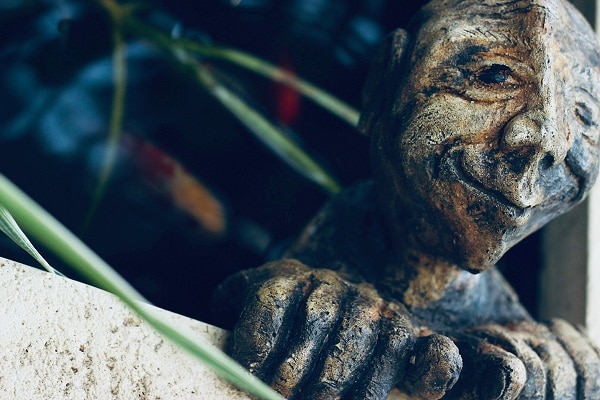Dumping rubbish in landfill isn’t a long-term waste solution in Australia.
Although Aussies have become better at recycling in the last 20 years, we still landfill more than 21 million tonnes of waste each year.
Since China stopped accepting recycling from us (and much of the rest of the world), stockpiles of waste aren’t going anywhere. It’s an issue most are already aware of. But it was a recent documentary, Broken, where the vast scale of the problem was revealed.
Whilst there’s no immediate way to fix the waste crisis, small everyday changes do make an impact. Reducing waste, recycling, upcycling and repurposing – it all helps.
If you have old items that are broken, unusable or taking up space, use this time to repurpose them. Here are some creative ideas to breathe new life into timeworn goods.
1. Repurposed Typewriter
There’s a Japanese word that turns repurposing into an art. Kintsugi, the art of precious scars. It teaches that broken or damaged items aren’t something to hide away but to display with pride.
In Kintsugi, they mend broken objects by aggrandising the damaged cracks with gold. They believe that when something has suffered damage and has a history, it becomes more beautiful.
I used this word as the inspiration behind my logo, the little typewriter.
Instead of disregarding a broken typewriter, I planted a chilli plant inside to give it purpose again. This was turned into a photograph and stencilled for the logo. The typewriter and plant are still thriving in the garden today.


There’s a story behind everything. If you can find a way to reuse an old item, there’s a uniqueness to what you create; a story behind its scars.
Other broken or unusable items around the house you could turn into a plant home or repurpose are:
- Shoes
- Filing cabinet or sets of drawers/bedside drawers
- Plastic laundry basket
- Wheelbarrow
- Watering can
- Shells
- Bowls
- Frames
- Basketball/netball (cut the top, fill with soil + add succulents or other hardy plants)
- Car tyres as a hanging plant for exterior walls
- Ladders into shelves for potted plants
- Rusty tools as ornaments to secure to the outside of a shed or decorate wall space
Be as imaginative as you dare.
Tip: Don’t forget to add small drainage holes to the repurposed item before planting anything inside.
2. Old Oven and Kitchenware
Turn your old oven and kitchenware items into succulent gardens.
Unusable ovens, fridges and other white goods are landfill’s worst enemy. To avoid overflowing landfill and reduce greenhouse gas emissions, it’s important to dispose of white goods properly in a designated facility.
Instead of the hassle, find the broken culprit a new home in your backyard. Spray paint it a different colour or leave as is with a few ‘potted’ succulent plants to spice things up.
Succulents are naturally hardy but they also grow in small amounts of soil, which makes them great for planting in strange places like a typewriter, kitchen oven or cooking pot.

3. Rubble, Limestone and Brick
Leftover rubble are building blocks for easy, creative DIY projects.
When I first moved into my rental, there were limestone-composite rock pieces abandoned at the side of the house. Now, they make a fireplace and fish pond which is home to six happy fish, a frog named Frankenstein and a bunch of water plants. DIY ecosystem!
Use brick, rocks, sandstone and other leftover construction materials to build a pond, fire pit, gabion wall or planter boxes. They add a rough, industrial texture to landscaped gardens and help keep materials away from landfill.
4. Plant and Succulent Cuttings
Why spend money on expensive garden plants when you can propagate cuttings instead?
Fill garden beds by cutting and replanting succulents to cultivate your own low-maintenance garden.
If you don’t have a starting point in your own, ask a friend. Plants such as Agave, Jade plants (money trees) and snake plants (Mother in Law’s tongue) are common in Perth backyards. Or check your local nursery, Facebook gardening groups or Gumtree for cheap cuttings.
Other plants to grow from cuttings include:
- Spider plants
- Aloe vera
- Echeveria
- Blue chalk sticks
- Mint
- Basil
- Cacti
- Frangipanis
- Native Australian plants
- Lavender
- Bamboo
- Vines
Even if you don’t have a green thumb, these are easy to keep alive in Australian gardens.

Tip: Check your local Bunnings for discounted plants. The clearance section usually has plants going for $1. They may look almost dead, but with a little love, they’ll green again and make a cost-effective difference to your home. This Madagascar Palm is a prime example.
5. Vinyl Records, DVDs and Cassette Tapes
Damaged music or movie goodies in the shed? Instead of clogging up bin and landfill space, turn them into a feature wall or decorative art piece.
Memorable vinyl that’s scratched can still have a place. Showcase your favourites in your home office, living area or man cave, or revamp an old table with surface damage by making a top for it from old records and glass.
6. Pallets and Plastics
Pallets are great for vertical gardens and feature walls, inside and out.
Plant spider plants, vines, herbs or succulents in empty plastic bottles. Cut in half and use the top. Fill with soil and take off the lid to use as drainage when watering your plants.
Don’t have access to pallets? Check nearby skip bins (ask first) or your local tip for salvageable items like reclaimed wood to make your own. Other thrown out goods such as doors and window frames are also good for repurposing around the home. Make a small greenhouse out of pallets and windows, decorate an outdoor space with old doors and turn broken plastic storage tubs into garden beds.
Many of these items take thousands of years to break down in landfill. But if you can give them another life, it saves the trouble of disposing of them yourself and contributes to a better environment.
Tip: Take advantage of verge collection for unloved or broken items you could home. This egg chair and table were both found after being thrown away.
Repurposing allows you to save money, energy and reduce the amount of waste sent to landfill. It also allows you to be as minimalist and as practical as possible.
Author Bio
What could be mistaken as a Cameron Crow movie (Almost Famous), Jayde Walker started out as an underage music journalist with one goal – to be a writer. Today, she’s a professional Content Writer and outreach prodigy who’s been helping businesses tell their story for more than 15 years. Jayde was first published in the West Australian in 1999 and wrote for local and international music magazines. After six years as a Senior Content Writer, Jayde now helps businesses create better content, connect with customers and get the most value from their stories through the little typewriter.























